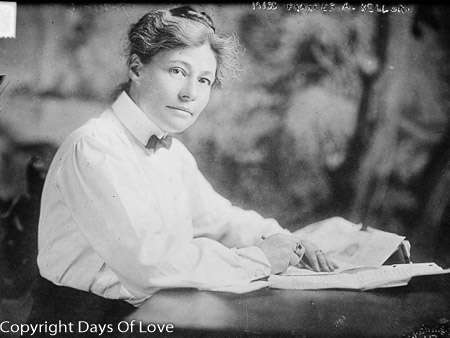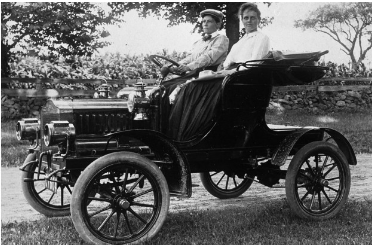

Partner Mary Dreier, buried together
Queer Places:
University of Chicago, 5801 S Ellis Ave, Chicago, IL 60637, Stati Uniti
Cornell University (Ivy League), 410 Thurston Ave, Ithaca, NY 14850
19 E 26th St, New York, NY 10010, Stati Uniti
118 E 54th St, New York, NY 10022, Stati Uniti
43 5th Ave, New York, NY 10003
Green-Wood Cemetery, 500 25th St, Brooklyn, NY 11232, Stati Uniti
 Frances
Alice Kellor (October 20, 1873 – January 4, 1952) was an American social
reformer and investigator, who specialized in the study of immigrants to
the United States and women. Frances
Kellor, an investigator at Hull-House and at the Rivington Street
Settlement in New York, and a shaper of much Progressive Era welfare
legislation, met Mary Dreier,
a prominent labour reformer and trade unionist, in 1904 and set up house
with her for the 47 remaining years of her life; a photograph of Kellor
and Dreier in a high-seated open motor car presents almost a caricature
of the heterosexual couple: Kellor, in a man’s cap, shirt and tie, is
the man behind the wheel, Dreier is the long-skirted decorous feminine
person seated beside.
Frances
Alice Kellor (October 20, 1873 – January 4, 1952) was an American social
reformer and investigator, who specialized in the study of immigrants to
the United States and women. Frances
Kellor, an investigator at Hull-House and at the Rivington Street
Settlement in New York, and a shaper of much Progressive Era welfare
legislation, met Mary Dreier,
a prominent labour reformer and trade unionist, in 1904 and set up house
with her for the 47 remaining years of her life; a photograph of Kellor
and Dreier in a high-seated open motor car presents almost a caricature
of the heterosexual couple: Kellor, in a man’s cap, shirt and tie, is
the man behind the wheel, Dreier is the long-skirted decorous feminine
person seated beside.
Frances Alice Kellor was born October 20, 1873 in Columbus, Ohio. During Kellors’ childhood, her father left the family, forcing her mother to move to Michigan to work as a laundress. Kellor could not afford to finish high school, leading her to work at a local news company where she eventually became an investigative reporter at the company. It was there that two sisters, Mary and Frances Eddy, took notice of her and helped fund Kellors’ college education. She received her law degree in 1897 from Cornell Law School, and received a scholarship to study sociology and social work at the University of Chicago. It was at the University of Chicago that she wrote her first scholarly article about equality among women and men in physical education. Kellor also began her study of prisons while at University of Chicago, which would lead to her first book Experimental Sociology (1901.)[1]
She was secretary and treasurer of the New York State Immigration Commission in 1909 and chief investigator for the Bureau of Industries and Immigration of New York State in 1910-13. She became managing director of the North American Civic League for Immigrants and a member of the Progressive National Committee. She also oversaw the American Association of Foreign Language Newspapers.[2]
She directed the National Americanization Committee (NAC), the most important private organization promoting Americanization during World War I. Speaking for the NAC in 1916, proposed to combine efficiency and patriotism in her Americanization programs. It would be more efficient, she argued, once the factory workers could all understand English and therefore better understand orders and avoid accidents. Once Americanized, they would grasp American industrial ideals and be open to American influences and not subject only to strike agitators or foreign propagandists. The result, she argued would transform indifferent and ignorant residents into understanding voters, to make their homes into American homes, and to establish American standards of living throughout the ethnic communities. Ultimately, she argued it would "unite foreign-born and native alike in enthusiastic loyalty to our national ideals of liberty and justice."[3] Unlike African American social reformers of the time, Kellor believed that enslavement made it impossible for African American women to lead moral, respectable lives. Kellor and her cohort of white reformers focused on improving recently emancipated African American women's efficiency, rather than attempt to challenge the racially restrictive segregationist practices of the Northern society.[4]

Frances Kellor and Mary Dreier
In 1916, she became the chairman of the Women's Committee for the National Hughes Alliance, headquartered in the Hotel Astor. The goal of the Hughes Alliance was to organize the women of the country to support Charles E. Hughes in his bid for President of the United States in 1916.[5]
Kellor focused her works on Women’s Rights on studying the treatment of women in education and the work force. Kellor did her work on Women’s Rights by completing field work at various locations including studying women in prison, women in the Hull-House in Chicago, women employees, and women in educational settings. In 1904 Kellor published the book Out of Work, in which she discusses immigrant unemployment in the United States. In it Kellow notes that little data had been taken on women’s unemployment due to the social opinion that unemployment had little to do with women. She also discussed reasons why women employees had not been able to attain the same standards through union organization as men, the helplessness of unemployed women, and unemployed women and prostitution.[6] Kellor argued for equal treatment of women in educational settings, specifically in physical education. In 1909 she published a book in collaboration with Gertrude Dudley called Athletic Games in the Education of Women, in which they argued that participating in sports could have positive effects for women, since it would allow to them to leave the confines of the home and would make them more socially active.[7]
Frances Kellor was secretary and treasurer of the New York State Immigration Commission in 1909 and chief investigator for the Bureau of Industries and Immigration of New York State in 1910-13. She was brought on by Theodore Roosevelt’s 1912 presidential campaign, to help write the Progressive Party’s platform. This election marked the first time the party had taken up immigration as a key issue. The platform promised to provide immigrants more opportunities to succeed, as well as reverse policies that neglected immigrants and their rights. Roosevelt lost the election to Woodrow Wilson, but Kellor continued her fight for immigrant rights. At the time, Kellor was the director of the North American Civic League. She began advocating for increased collaboration between private, state, and national efforts, aimed at assimilating, educating, and protecting the rapidly growing immigrant population. In 1914, she left the American Civic League and formed the Committee for Immigrants in America. This committee fought for immigrant rights and education.
The contest "The Immigrant in America" was sponsored by wealthy sculptor Gertrude Vanderbilt Whitney and organized by her right-hand woman, Juliana R. Force. It was the brainchild of Kellor.
Kellor’s efforts resulted in more than 13% of non-English-speaking immigrants enrolling in citizenship classes by 1915. The movement continued to make progress, but Kellor was not satisfied. She began pressuring the federal government to act and aide immigrants in regards to protection, education, and opportunity. Kellor organized and promoted the National Americanization Day, to be held on July 4, 1915. Over 150 cities nationwide partook in this holiday, which celebrated and welcomed naturalized immigrants . She also oversaw the American Association of Foreign Language Newspapers[1] She directed the National Americanization Committee (NAC), an important private organization promoting Americanization during World War I. Speaking for the NAC in 1916, she proposed Americanization programs that to combined efficiency and patriotism. It would be more efficient, she argued, once the factory workers could all understand English and therefore better understand orders and avoid accidents. Once Americanized, immigrants would grasp American industrial ideals and be open to American influences. This would make them less subject to strike agitators or and foreign propagandists. The result, she argued would transform less knowledgeable residents into understanding voters, making their homes into American homes, and to establishing American standards of living throughout the ethnic communities. Ultimately, she argued it would "unite foreign-born and native alike in enthusiastic loyalty to our national ideals of liberty and justice."[8]
Kellor felt that crime was due to poor education and unemployment, which ran contrary to the popular belief of the time that criminality was biological.[9][10] She published several articles on the American prison systems as well as one book, Experimental Sociology: Descriptive and Analytical. In her research Kellor examined race and the many conditions that led Southern African Americans criminals to engage in crime. In her articles Kellor also discussed the effect of prison life on crime and placed special emphasis on how debilitating it could be for the social life of African Americans, which in turn could perpetuate crime.[11] She felt that two of the solutions to this issue would be rehabilitation as well as reintegration programs.[11][9]
Kellor never married. She maintained a long-term relationship with another woman, Mary Dreier, one of two wealthy sisters who played leading roles in the progressive movement in New York. They shared a home from 1905 until Kellor's death.[12] Kellor is also connected with Agnes Nestor and Mary (Molly) Dewson.
She died in New York City on January 4, 1952, and is buried alongside Mary Dreier at Green-Wood Cemetery, Brooklyn, New York.
My published books: